Granby, Connecticut
Granby is a town in far northern Hartford County, Connecticut, United States. The town is part of the Capitol Planning Region. The population was 10,903 at the 2020 census.[1] The town center is defined as a census-designated place known as Salmon Brook. Other areas in town include North Granby and West Granby. Granby is a rural town, located in the foothills of the Litchfield Hills of the Berkshires, besides the suburban natured center, the outskirts of town are filled with dense woods and rolling hills and mountains. From the 1890s to the 1920s many immigrants from Sweden came to reside in the town.
Granby, Connecticut | |
|---|---|
| Town of Granby | |
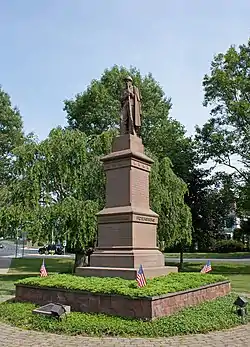 Civil War Soldiers' Monument in the town center | |
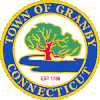 Seal | |
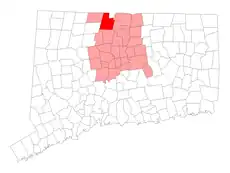 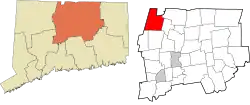 | |
| Coordinates: 41°57′44″N 72°50′22″W | |
| Country | |
| U.S. state | |
| County | Hartford |
| Region | Capitol Region |
| Settled | 1723 |
| Incorporated | 1786 |
| Villages | Granby (Salmon Brook) Five Points Goodrichville Hungary Mechanicsville North Granby Pegville West Granby |
| Government | |
| • Type | Board of selectmen-town manager |
| • First Selectman | Barry Scott Kuhnly (R) |
| • Selectmen | Mark C. Neumann (R) Edward E. Ohannessian (R) Sally S. King (D) James Lofink(D) |
| • Town manager | John D. Ward |
| Area | |
| • Total | 40.8 sq mi (105.7 km2) |
| • Land | 40.7 sq mi (105.4 km2) |
| • Water | 0.2 sq mi (0.4 km2) |
| Elevation | 550 ft (167 m) |
| Population (2020) | |
| • Total | 10,903 |
| • Density | 270/sq mi (100/km2) |
| Time zone | UTC-5 (Eastern) |
| • Summer (DST) | UTC-4 (Eastern) |
| ZIP Codes | 06035, 06060, 06090 |
| Area code(s) | 860/959 |
| FIPS code | 09-32640 |
| GNIS feature ID | 0213434 |
| Major highways | |
| Website | www |
History
Granby was founded by people who lived in Simsbury and settled as early as 1723. Granby was part of Simsbury until 1786, when it became independent.[2] The name is from Granby, Massachusetts in return, where it was named in honor of John Manners, Marquess of Granby.
Part of Southwick, Massachusetts, known as "the Notch" seceded from Massachusetts in 1774, just before the outbreak of the American Revolutionary War. This territory became part of Granby when it seceded from Simsbury, but was returned to Southwick as part of an 1803–1804 border dispute compromise. (See History of Massachusetts.)
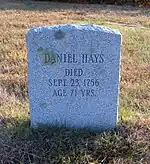
In 1707, Daniel Hayes (born c. 1685 – died 1756), then aged twenty-two, was captured and kidnapped by a hostile indigenous tribe and carried off to Canada. The capture was witnessed, and a rescue party raised, but the group did not catch up with the captors. He was tied up each night, and bound to saplings. It took thirty days to reach Canada, at which point Hayes was forced to run the gauntlet. Near the end of the gauntlet, he hid in a wigwam to avoid an attempted blow by a club. The woman in the wigwam declared that the house was sacred, and having lost a husband and son to a war, adopted Hayes as her son. He remained for several years, attending to the woman. Eventually, he was sold to a Frenchman, who learned that Hayes had skill as a weaver, so put him to work in that business. Hayes managed to earn enough to buy his freedom after two years. He then returned to Simsbury, settled down on a farm and married. He became prominent, both in civil affairs as well as the church at Salmon Brook (now Granby).[3]
The first unauthorized coins minted in the American colonies, and the first in Connecticut, were struck by Dr. Samuel Higley in 1737 from copper mined from his own mine. The coins, including the Trader's Currency Token of the Colony of Connecticut were minted in North Simsbury, now called Granby.[4] These coins were made of pure copper, which is very soft. Consequently, there are very few in existence today. The first coins were inscribed with a value of three pence. Later versions carried the phrase "Value me as you please."[5]
In 1858, the eastern part of the town broke off and formed to become East Granby, the town is one of the newly established town in the state.
In 2009 Connecticut Magazine ranked Granby the #3 overall Connecticut small town (population 10,000–15,000) to live in, and #1 small town in Hartford County.[6]
The town seal depicts the Dewey-Granby Oak, a large white oak estimated to be 450–500 years old, thought to be one of the oldest trees in New England.[7]
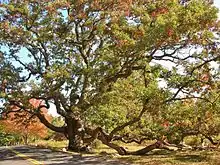
Geography
According to the United States Census Bureau, the town has a total area of 40.8 square miles (105.7 km2), of which 40.7 square miles (105.4 km2) is land and 0.15 square miles (0.4 km2), or 0.33%, is water.[8] The town center (Salmon Brook CDP) has a total area of 3.0 square miles (7.8 km2), all land. According to Google Earth, the highest point in Granby is 1,153 feet (351 m) in West Granby at 41°55'57.81" N 72°53'17.18" W. The town is covered in dense woodlands containing animals such as the black bear, eastern moose, and white-tailed deer. Granby is warm and often humid in summer, with occasional thunderstorms, while winter can have heavy snow and cold temperatures. Snow and cold temperatures are not uncommon in early spring and late fall due to the town's location in the Berkshires.
Demographics
| Census | Pop. | Note | %± |
|---|---|---|---|
| 1820 | 3,012 | — | |
| 1850 | 2,498 | — | |
| 1860 | 1,720 | −31.1% | |
| 1870 | 1,517 | −11.8% | |
| 1880 | 1,340 | −11.7% | |
| 1890 | 1,251 | −6.6% | |
| 1900 | 1,299 | 3.8% | |
| 1910 | 1,383 | 6.5% | |
| 1920 | 1,342 | −3.0% | |
| 1930 | 1,388 | 3.4% | |
| 1940 | 1,544 | 11.2% | |
| 1950 | 2,693 | 74.4% | |
| 1960 | 4,968 | 84.5% | |
| 1970 | 6,150 | 23.8% | |
| 1980 | 7,956 | 29.4% | |
| 1990 | 9,369 | 17.8% | |
| 2000 | 10,347 | 10.4% | |
| 2010 | 11,282 | 9.0% | |
| 2020 | 10,903 | −3.4% | |
| U.S. Decennial Census[9] | |||
As of the census[10] of 2000, there were 10,347 people, 3,781 households, and 2,994 families residing in the town. The population density was 254.3 inhabitants per square mile (98.2/km2). There were 3,887 housing units at an average density of 95.5 per square mile (36.9/km2). The racial makeup of the town was 97.54% White, 0.61% African American, 0.23% Native American, 0.74% Asian, 0.02% Pacific Islander, 0.23% from other races, and 0.63% from two or more races. Hispanic or Latino of any race were 1.30% of the population.
There were 3,781 households, out of which 39.5% had children under the age of 18 living with them, 71.1% were married couples living together, 5.9% had a female householder with no husband present, and 20.8% were non-families. 16.5% of all households were made up of individuals, and 6.8% had someone living alone who was 65 years of age or older. The average household size was 2.71 and the average family size was 3.06.
In the town, the population was spread out, with 27.3% under the age of 18, 3.7% from 18 to 24, 30.1% from 25 to 44, 27.8% from 45 to 64, and 11.0% who were 65 years of age or older. The median age was 40 years. For every 100 females, there were 98.7 males. For every 100 females age 18 and over, there were 95.1 males.
The median income for a household in the town was $81,151, and the median income for a family was $90,057. Males had a median income of $63,093 versus $42,203 for females. The per capita income for the town was $33,863. About 1.5% of families and 3.1% of the population were below the poverty line, including 3.6% of those under age 18 and 3.2% of those age 65 or over.
Government and politics
Once a Republican stronghold, Granby has become friendlier to Democrats in recent presidential elections.[11] Granby voters flipped from supporting Republican Mitt Romney in 2012 to Democrat Hillary Clinton in 2016.[12][13] This mirrored a national trend of suburban voters shifting from Donald Trump. In 2020, Democrat Joe Biden won Granby by more than 10 percentage points.[14]
| Year | Democratic | Republican | Third Parties |
|---|---|---|---|
| 2020 | 54.68% 4,029 | 42.97% 3,166 | 2.35% 173 |
| 2016 | 47.84% 3,114 | 45.58% 2,967 | 6.58% 428 |
| 2012 | 48.28% 3,079 | 50.50% 3,221 | 1.22% 78 |
| 2008 | 53.23% 3,456 | 45.39% 2,947 | 1.37% 89 |
| 2004 | 48.25% 3,015 | 49.74% 3,108 | 2.02% 126 |
| 2000 | 45.73% 2,576 | 48.80% 2,749 | 5.47% 308 |
| 1996 | 42.56% 2,196 | 44.22% 2,282 | 13.22% 682 |
| 1992 | 35.74% 1,998 | 39.03% 2,182 | 25.22% 1,410 |
| 1988 | 38.31% 1,882 | 60.68% 2,981 | 1.02% 50 |
| 1984 | 28.19% 1,247 | 71.47% 3,161 | 0.34% 15 |
| 1980 | 28.42% 1,196 | 52.58% 2,213 | 19.01% 800 |
| 1976 | 35.60% 1,253 | 63.86% 2,248 | 0.54% 19 |
| 1972 | 32.36% 1,044 | 66.68% 2,151 | 0.96% 31 |
| 1968 | 35.82% 954 | 59.90% 1,595 | 4.28% 114 |
| 1964 | 55.16% 1,368 | 44.84% 1,112 | 0.00% 0 |
| 1960 | 34.88% 850 | 65.12% 1,587 | 0.00% 0 |
| 1956 | 23.05% 446 | 76.95% 1,489 | 0.00% 0 |
| Voter Registration and Party Enrollment as of November 1, 2022[16] | |||||
|---|---|---|---|---|---|
| Party | Active Voters | Inactive Voters | Total Voters | Percentage | |
| Republican | 2,440 | 189 | 2,629 | 29.20% | |
| Democratic | 2,473 | 183 | 2,656 | 29.50% | |
| Unaffiliated | 3,203 | 343 | 3,546 | 39.39% | |
| Minor parties | 151 | 19 | 170 | 1.88% | |
| Total | 8,267 | 734 | 9,001 | 100% | |
Education
Granby's public school system consists of one primary school, one intermediate school, one middle school, and one high school.
- Kelly Lane Primary School (Grades: K–2)
- Wells Road Intermediate School (Grades: 3–5)
- Granby Memorial Middle School (Grades: 6–8)
- Granby Memorial High School (Grades: 9–12)
National Register of Historic Places
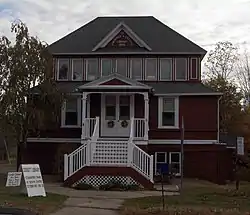
Notable people
- Adam Burt (born 1969), former NHL player, played with the Hartford Whalers
- Joe Bouchard (born 1948), musician, member of Blue Öyster Cult
- Jesse Camp (born 1979), MTV VJ
- Chauncey Forward (1793–1839), congressman from Pennsylvania
- Bryan Nash Gill (1961–2013), artist
- George S. Godard (1865–1936), librarian
- Philip C. Hayes (1833–1916), congressman from Illinois
- Byron Kilbourn (1801–1870), surveyor and politician
- Rebecca Lobo (born 1973), former Women's National Basketball Association player
- Garrett Lucash (born 1978), figure skater
- Theodore Mills Maltbie (1842–1915), lawyer and politician
- William M. Maltbie (1880–1961), Chief Justice of the Connecticut Supreme Court
- Aaron Draper Shattuck (1832–1928), painter of the White Mountain School
Notes
- "Census - Geography Profile: Granby town, Hartford County, Connecticut". United States Census Bureau. Retrieved December 16, 2021.
- "Town of Southwick, Massachusetts". Archived from the original on August 5, 2007. Retrieved October 14, 2007.
- Phelps 1845, pp. 37–44.
- Federal Writers' Project (1938). Connecticut: A Guide to Its Roads, Lore and People. US History Publishers. p. 58. ISBN 978-1-60354-007-0. Retrieved September 23, 2010.
- American Numismatic Society (1897). Proceedings of the American Numismatic and Archeological Society. p. 16. Retrieved October 20, 2010.
- "Rating the Towns 2009: Cities 10,000-15,000". Connecticut Magazine. November 1, 2009. Retrieved April 8, 2022.
- "The Ancient Oak of Granby". February 25, 2011.
- "Geographic Identifiers: 2010 Demographic Profile Data (G001): Granby town, Hartford County, Connecticut". U.S. Census Bureau, American Factfinder. Archived from the original on February 12, 2020. Retrieved November 26, 2012.
- "Census of Population and Housing". Census.gov. Retrieved June 4, 2015.
- "U.S. Census website". United States Census Bureau. Retrieved January 31, 2008.
- "General Elections Statement of Vote 1922".
- Statement of Vote ct.gov
- Statement of Vote ct.gov
- Statement of Vote ct.gov
- "General Election Statements of Vote, 1922 – Current". CT Secretary of State. Retrieved December 16, 2021.
- "Registration and Party Enrollment Statistics as of November 1, 2022" (PDF). Connecticut Secretary of State. Archived from the original (PDF) on October 22, 2023. Retrieved October 22, 2023.
{{cite web}}:|archive-date=/|archive-url=timestamp mismatch (help)
References
- Phelps, Noah Amherst (1845). History of Simsbury, Granby, and Canton; from 1642 To 1845. Hartford: Press of Case, Tiffany and Burnham.

